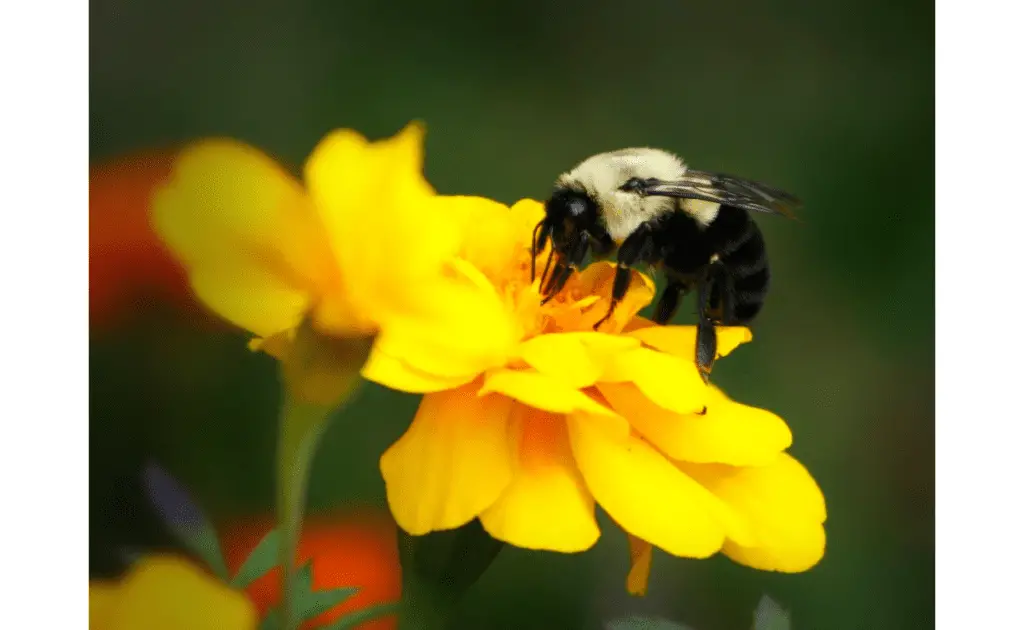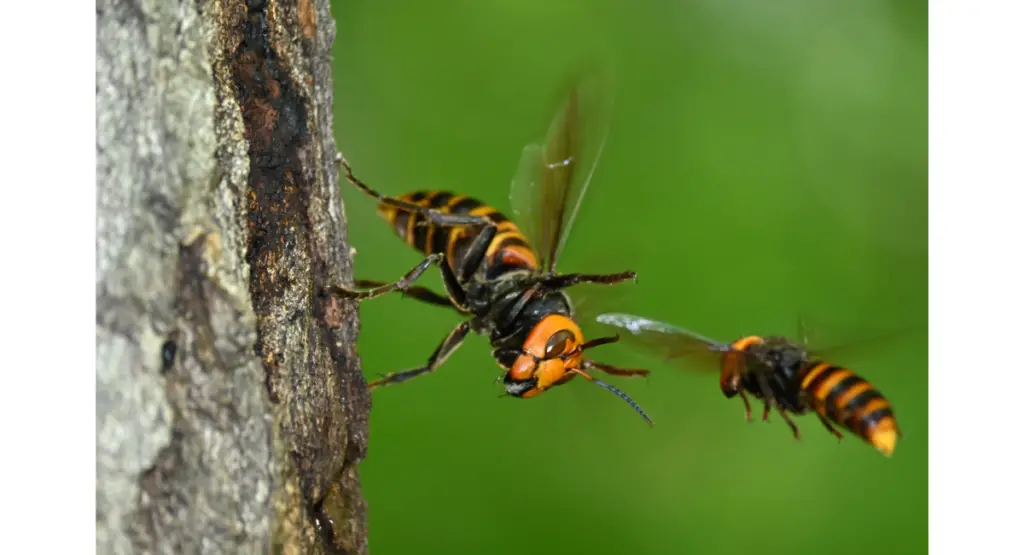
As a general rule to attract bees to your garden add bright single layer flowers. By adding easy to access pollen you will attract bees to your garden. Other ways to attract bees is provide bee friendly housing. Make sure to remove sick and dying plants. Make sure to avoid pesticide where bees will be or you may kill the bees you’re trying to attract.
Bees are likely to be in trouble. The population is declining, and it’s affecting us all in more ways than we realize. It might tempt you to think that this problem doesn’t affect you because you don’t even like bees, but you’d be wrong. This is a serious issue that needs to be addressed. In this article, we’ll explore what materials attract bees, how to attract bees but not wasps, the best annual flower seeds for bees, and how someone can create a bee friendly environment.
What Materials Attract Bees?
Bees need four things to survive: food, water, air, and shelter. When it comes to materials that attract bees, there are many options. Bees get attracted to light-colored brick and wood, particularly if the surface has been weathered or has been exposed to the elements for a long time. In addition, bees prefer rough-textured surfaces over smooth ones. This includes materials such as pea gravel and concrete blocks besides brick and wood.
Another material worth considering is untreated lumber. Untreated lumber is a great way to attract bees because of its all-natural scent-it’s made from trees!-and because it’s often covered in tiny cracks and crevices where bees can hide their eggs.
Bees also get attracted to a variety of colors and scents, but there are some colors and scents that bees find to be more enticing than others. Bees may also become attracted to materials that have a certain texture or shape. If you want bees to come to your home or garden, it may be helpful to use one or more of the following materials:
- Color: Bees are said to get particularly attracted to the color blue and shades of yellow and purple. They also like bright colors such as white, orange, and red.
- Scent: Bees like scents that are strong and sweet, including fragrances such as vanilla, peppermint, almond extract, and rosemary (paid link).
- Texture: Bees get drawn toward materials that have a smooth surface and/or shiny appearance. For example, they may become attracted to polished wood or shiny metal.
- Shape: Though they are not attracted to all geometric shapes, bees prefer shapes that have rounded corners and curves rather than straight lines.
How Do You Attract Bees But Not Wasps?

There are many flowers that attract bees but not wasps. Some examples are: lavender, alyssum, coneflower, yarrow, and Black-Eyed Susan. Learn how to use lavender in your garden in our post here.
Bees are important pollinators. If you want to attract bees to your garden, but not wasps, there are a few things you can do:
Plant Shrubs and Flowers That Only Attracts Bees and Not Wasps!
You can also plant trees and shrubs that attract bees but not wasps. Some examples are: redbud trees (paid link) and flowering crab apples. Also consider adding bee houses to your garden so they have places to live and lay eggs.
Set Up a Bee House
Bees like to live in dark spaces where others won’t bother them. Placing a bee house (paid link) where you can observe them without disturbing them will help you learn more about them and their needs.
Plant Bee-Friendly Flowers
Certain flowers attract bees, but not wasps, by providing a place for them to lay their eggs and food for their larvae.
Leave Clover
Clover is a plant that is attractive to both bees and wasps alike. Leaving it in your yard will allow you to attract both kinds of insects, but it’s important to have other flowers as well or else there won’t be enough food for the wasps’ larvae and they’ll die off before their population can grow properly.
How Do You Create a Bee Friendly Environment- Gardening Plants that attract
In order to create a bee friendly environment, there are four things you can do:
1. Plant Native
Planting native plants is a great way to create a bee friendly environment. Native plants will attract more pollinators than non-native plants because they will often provide food for both adults and larvae. Native plants are also more resistant to pests and disease, which allows them to grow stronger and healthier. This means they produce more nectar and pollen that pollinators can use as food sources!
2. Avoid Pesticides
Pesticides have been shown to be harmful not only for bees but also other pollinators like butterflies, moths and hummingbirds! To avoid using pesticides in your yard or garden, try using companion planting methods instead. Companion planting allows you to plant flowers and vegetables together so they can help each other grow better by attracting beneficial insects while repelling pests and diseases. For example, marigolds repel nematodes (tiny worms) which attack tomato roots! Find out more about marigolds in this post.
3. Provide Shelter
Find a suitable location for the hive. You want it to be in a sunny area where there’s plenty of food for the bees. If you live in an urban area, there are usually public green spaces where you can place your hive. You’ll also want to find a tree or bush that stands out from the rest of your yard.
Bees particularly like apple trees, but if you don’t have one nearby, there are some other options. Find an area on your property that is easy to remember and keep in mind when looking at the hives and is a landmark for you or others who might look for them.
4. Provide Bees with Food and Water
Bees eat pollen, which they can get from flowers, plants, trees, and grasses. Bees also need water to help them digest their food; you can provide water by creating a small flower bed near your house, then watering it regularly during dry periods (it’s best not to overwater).
What Are Best Annual Flower Seeds for Bees?
Seed packets are a great way to add pollen- and nectar-rich annuals to your garden. Here are some of the best annual flower seeds for bees:
- Snapdragons: Snapdragons are a superb choice for bees, because they have tubular flowers and are easy for bees to get into. They also provide pollen and nectar. They come in shades of yellow, pink, red, purple, white, and orange.
- Portulaca: Portulaca is a succulent with a long bloom time and small but brightly colored flowers that appeal to bees. They grow in full sun and need sandy soil.
- Zinnias: Zinnias are gorgeous flowers with large petals and vivid colors that bees love. They’re easy to grow from seeds as well.
- Marigolds: Marigolds can be an annual or perennial flower depending on the variety you choose; they range in size from 4 inches tall to 3 feet high and can get found in shades of orange, red, yellow, and white.
Why are bees not coming to my garden?
There are many bee species and attracting bees is not always easy. If you tried the ways listed look too see if there is any reason there not coming to your garden. Is there a large wasp colony near by. If your lawn care adds chemicals it could be harming them. Some places have a low bee population which can cause problems. Do you see other insects like butterflies they can be an indicator of if your on the right path.
Is it good attracting bees to your garden?
It is very good to attract bees to your garden. Attracting bees helps pollination for you and a safe home for them. If solitary bees find your garden and its prepared for them you can plan to see many more shortly. By bring bees into my garden my vegetable production has increased without the use of fertilizers.
This post contains affiliate links. If you make a purchase through these links, we may receive compensation at no additional cost to you.


